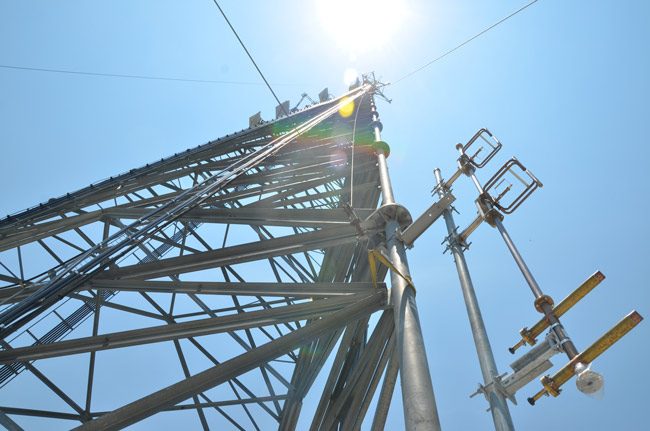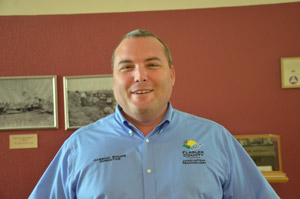
Residents and business owners have their own varied views of government. But they all depend on essential services: roads, drainage systems, utilities, and above all, public safety—police, fire, ambulance services.
All those services (not just public safety) rely in part or in whole on a multi-million dollar wireless communications system run by county government, and used by all local governments. That’s the backbone of communication towers, repeaters, radios and dispatchers of the emergency and non-emergency communications system without which cops, paramedics, firefighters or even water and sewer workers couldn’t talk to each other across distances. With it, they log upwards of 3 million communications a year.
Flagler County government financed the current $11.3 million system through a bond levy in 2004. Cities get to use it at no charge except to pay the cost of radios and to pay for certain upgrades—payments Palm Coast government has refused to make past a certain point. (it owes $600,000.)
The system is nearing its end, with spare parts no longer to be manufactured beyond this year. The county learned of this several years ago, and has been planning an upgrade—not fast enough to Palm Coast’s taste, but deliberately and reliably enough as far as the county sees it. Planning has accelerated under IT Director Jarod Shupe, whose command of the system is beyond most lay people’s understanding, and whose light-speed presentations can leave listeners baffled by a mixture of complexity and lingo.
In a special county commission workshop attended by Palm Coast, Flagler Beach and Bunnell officials, Shupe (without a translator) unveiled the essence of the county’s planned upgrade to a new system. “They’ve seen the nuts and bolts of it, they’ve never seen it all in one package,” Shupe said of the participants. “We were rushing, trying to get this done.”

But there was a catch: while the county unveiled new tower locations (always a touchy issue with residents), it did not have cost estimates yet. The county administration will be presenting the cost estimates behind closed doors, to county commissioners individually. It does not want to reveal its estimates until after receiving responses for its request for proposals. What’s certain is that, given the 2004 cost of the system, it’ll be one of the largest expenses county government will have to contend with, and the means of paying for it are still uncertain.
On the other hand, the county is just about ready to issue its request for proposals, with bid awards in January or February and tower construction taking place later in 2018. The system would be installed and tested in 2019, and go operational in the fall of 2019.
The system will require a new set of communications towers. There will be six in all, instead of five, with five going up in places that have no tower currently, and one replacing an existing tower. The towers will range in height from 160 to 350 feet, with the two tallest ones to go up at the intersection of State Road 100 and County Road 305 (site of a coming fire station for the west side) and on a county parcel at Cody’s Corner, off of State Road 11.
“This has been a long-standing issue we’ve been working on, we’re excited to bring it about,” County administrator Craig Coffey said by way of introduction. “It’s going to be a big investment.”
The current system will be replaced, with channel capacities to be increased from eight to 10, but also tripling the capacity for “talk paths” on channels. It will accommodate 2,100 radios (a few more than currently in use), and it’ll interconnect with the systems of neighboring counties, improving situations where agencies across county lines need to rely on mutual aid on given emergencies: for example, when big or multiple fires erupt, Flagler’s firefighters may need to call in firefighters from neighboring counties to help—and to communicate with them seamlessly. The system will enable that.
Originally the scope of the emergency system’s coverage was to ensure that 90 percent of the county is properly covered, which means that a responder wearing a radio on a belt is able to communicate in 90 percent of the county’s area. Based on proposed tower placement for the new system, coverage area would rise to 97 percent, outdoors and west of U.S. 1, and to 95 percent east of U.S. 1, with improved in-building coverage. The overwhelming number of single-family homes would be covered, regardless of where the responder happens to be in any given structure.
The remaining 5 percent may represent a fraction of the county but also contain a disproportionate number of people: big schools and big box stores, which have been notorious dead zones for emergency communications. To address that at the three schools most affected—Flagler Palm Coast High School, Matanzas High and Buddy Taylor Middle—and at Florida Hospital Flagler, the county will be seeking to install amplifiers. Shupe said big box stores would be in the coverage area with the new system. Some infrastructure retrofitting may be necessary, with the cost share to be defined by ordinance.
The system would also have wi-fi spots for government staffers, potential internet service capabilities in emergencies, and would include noise-cancelling capabilities that users favor.
Currently, the county rents space on most of its emergency communication towers. That would be phased out, with county-owned towers on county-owned land, thus saving an estimated $4.2 million over 15 years. Conversely, the county will make space available on its own towers to rent to service providers or government agencies, potentially generating substantial revenue.
When it comes to emergency communications, the public doesn’t generally want to hear about the sausage-making part of it—the backbone, the lingo, even, to some extent, the cost. It wants it all to work reliably and unfailingly. But the same public will often howl the moment it hears of a proposed communications tower going up in its backyard. That was the case in late 2015 and 2016, when the county had three big tower sites in the works until, by May last year, it scrapped the whole plan because of too much opposition, particularly against a proposed tower on South Anderson Highway along the Intracoastal.
And the towers this time? “We looked at all of our available land throughout the county,” Shupe said, working with the cities and the school board along the way. The school board proposed lands of its own. “This is the best that we came out with, the best locations that’ll fit our system based upon all the projection and all the systems that we’ve done.”
The towers, which will replace the county’s existing five towers, break down this way:
- A new 250-foot tower on a county parcel at Matanzas Woods Parkway near I-95. There’s already a higher tower there, but while the county thought it could take ownership of that tower, that proved unfeasible.
- A new, 350-foot tower on a county property near Cody’s Corner at State Road 11.
- A new 190-foot tower on a county property in Plantation Bay. (“We’re already anticipating some opposition from this,” Coffey, the county administrator, said. But because it’s a lower height, the tower will not have to be lit.)
- A new 350-foot tower on a county property near the intersection of State Road 100 and County Road 305.
- Replacement of the existing 250-foot tower at the county jail.
- A new 160-foot tower off the east end of the Government Services Complex.
For about half a year to a year, the old and the new system will be operational side by side. As for not releasing cost estimates, “we’ll be careful with releasing that,” Shupe said, “those are numbers that we think we can get around but until we see it we just don’t want somebody to know what our estimated number is and then work to that number.”
But that will keep the financing question in the dark, at least for a while.
“We have to work on financing as we pay off one note and we’re trying to bring on the other note,” Coffey said of the remaining payments due on the 2004 bond issue. “There’ll be some interest-holding costs, there’ll be some long-term savings going to this system potentially but there’ll also be a lot of transition costs, trying to run two systems at the same time.”
The existing system is all authorized for payments. The new system is not—not for this year, not for next year.
The presentation drew no public comment and barely any comments or questions from commissioners.
![]()
The full presentation on the next-generation radio system (2017)
Click to access 2017-11-13-Workshop-Agenda-and-backup.pdf





























Lou says
The County Administrator nor the Commissioners are qualified to select a system based on vendors biased presentation.
The Commissioner shoul appoint qualified RF (radio frequency) experienced volunteers to study and make recommendations to the County Commissioners.
Big box stores and schools are shielded from RF, including cellular signal by the metal construction. RF power from cellphones to penetrate such construction far exceed FCC permitted RF power.
Stop wasting taxpayers money by making vendors rich.
Wishful thinking says
Where in Plantation Bay pray tell? Thanks FlaglerLive? Next to the abandoned hotel? On the 9.5 acres on top of our homes next to old Dixie?
FlaglerLive says
Sorry about not initially including the full presentation and overhead images of the location of each tower. That’s now been added. You can go directly to the proposed location of the Plantation Bay tower by following this link: https://flaglerlive.com/wp-content/uploads/2017-11-13-Workshop-Agenda-and-backup.pdf#page=20
John dolan says
When the County switched from the old reliable motorola radios to the Maxcom radios the system was already obsolete, and nobody was held accountable.
I also don,t understand why Flagler went with a system that can’t be monitored by citizens?Volusia county can be picked up on regular scanners.As a citizen I want to know what is going on in my community. How did we lose our rights to moniter radio frequencies owned by the public?
Concerned Citizen says
@ John Dolan
You aren’t guaranteed rights to monitor public safety frequencies. A good majority of Law Enforcement agencies encrypt their radio transmissions to keep the general public from getting information that isn’t their business.
Also the public does not own radio frequencies the FCC does. In order to use them you need to be licensed for most of them. That includes County as well as private businesses and even Amateur Radio Operators.
Information like drivers license numbers, social security numbers and active warrant information are often transmitted over the air. granted it’s less with CAD systems and laptops now. Scrambling that and making it hard to get is their prerogative. I suppose plenty of people can get the proper radios and have someone program them but that’s supposed to be illegal to own as well.
I’m all for our LEO community having means to transmit secure information to stay safe. If citizen A hears that there is a warrant about to be served on citizen B and A is his friend he might just give him a heads up. That creates a dangerous situation for all involved.
To take it one step more I think Fire Rescue should be more secure as well. All to often I hear patient information being transmitted in the clear. I often wonder how this conflicts with HIPPA Law’s. Not sure the public needs to know what’s going on with a heart attack patient en route to the ER.
Robert Lewis says
I see a lot of towers being built in the southern, unpopulated part of Flagler County.
What about the rest of us in Palm Coast?
Lou says
The “airwaves” are owned by the public, FCC just regulats it.
Not every government communication justify encryption.
JOHN DOLAN says
Our SS numbers and Driver License numbers are being sold by the The State and agencies like Equifax. Take the recent Apache Strut Scenario. The Public owns the Airwaves by the way, the FCC regulates.